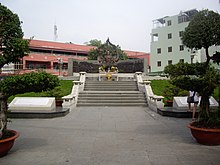Although Vietnam is a socialist country Mahayana is tolerated by the government and flourishes there. The official attitude encourages temples to be used as recreation venues (spiritual tourism) for the public with the population approaching 100 million. This tolerance is probably due to the events surrounding the self-immolation of Thich Quang Duc in 1963 which also influenced many Western Buddhists who were in the formative stage of Theravada at the time. (In the far south of Vietnam Theravada is practised.) Bikkhu Bodhi was in 1967 initially ordained into Vietnamese Mahayana.
" From 1954 to 1975, Vietnam was split into North and South Vietnam. In a country where surveys of the religious composition estimated the Buddhist majority to be approximately 50 to 70 percent,[16][17][18][19][20][21][22] South Vietnamese President Ngô Đình Diệm’s policies generated claims of religious bias. As a member of the Catholic Vietnamese minority, he pursued pro-Catholic policies that antagonized many Buddhists.
Further information: Roman Catholicism in Vietnam § Roman Catholicism in South Vietnam (1954–1975)
Monument to Thích Quảng Đức, who burned himself to death in 1963 in protest against the persecution of Buddhists by South Vietnam’s Ngô Đình Diệm administration
In May 1963, in the central city of Huế, where Diệm’s elder brother Ngô Đình Thục was the archbishop, Buddhists were prohibited from displaying Buddhist flags during Vesak celebrations.[23] Yet few days earlier, Catholics were allowed to fly religious flags at a celebration in honour of the newly-seated archbishop. This led to widespread protest against the government; troops were sent in, and nine civilians were killed in the confrontations. This led to mass rallies against Diệm’s government, termed as the Buddhist crisis. The conflicts culminated in Thích Quảng Đức’s self-immolation by lighting himself on fire in protest of the persecution of Buddhists. President Diệm’s younger brother Ngô Đình Nhu favored strong-armed tactics, and Army of the Republic of Vietnam Special Forces engaged in the Xá Lợi Pagoda raids, killing estimated hundreds.[citation needed] Dismayed by the public outrage, the U.S. government withdrew support for the regime. President Diệm was deposed and killed in the 1963 coup.[24][25]
Political strength of the Buddhists grew in the 1960s as different schools and orders convene to form the Unified Buddhist Sangha of Vietnam. Leaders of the Sangha like Thích Trí Quang had considerable sway in national politics, at times challenging the government.
With the fall of Saigon in 1975, the whole nation came under Communist rule; many religious practices including Buddhism were discouraged. In the North, the government had created the United Buddhist Sangha of Vietnam, co-opting the clergy to function under government auspices, but in the South, the Unified Buddhist Sangha of Vietnam still held sway and openly challenged the communist government. The Sangha leadership was thus arrested and imprisoned; Sangha properties were seized and the Sangha itself was outlawed. In its place was the newly created Buddhist Sangha of Vietnam, designed as the final union of all Buddhist organizations, now under full state control."
—Wikipedia
